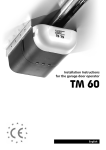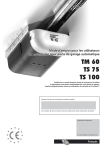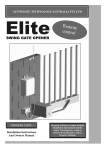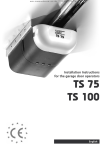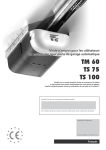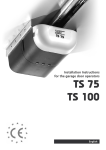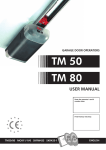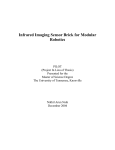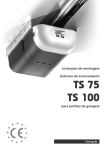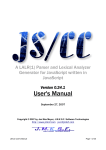Download Installation Instructions for the garage door operator
Transcript
Installation Instructions for the garage door operator TS Solar I TS Akku I This booklet must be handed over to the end-user together with the user-manual. 1V1 English Content Information and Remarks Remote Control Directives and Regulations Use of the operators Garage Doors The installers declaration of conformity Older Garage Doors Important Information for the Installer 3 Instruction for the users Security Advises for the Installation 4 Programming the Hand Transmitters 18 Basics Programming Transmitter and Receiver Clearing the receivers‘ memory Additional Information 19 Using the remote-control Criterias influencing the range Use with a HomeLink© System Installation Technical Information Different Conditions for Installation 5 Minimum space above the garage door Door Arm Extension C-Rail Extension Pre-Mounting the operator 6 Installing the operator 6 Minimum head room above the door Adjusting the running-length blocks Technical Data Wiring Messages from LED-lamps and operators lighting 21 Status Messages Error Messages Messages from the red LED-lamp and the operators lighting Additional Messages only from the red LED lamp 8 The Emergency Release 9 When there is a second entrance to the garage When the garage door is the only entrance The Solar Components TS Solar: Mounting the Solar Panel TS Solar: Using the Solar Panel TS Solar: Power Cord 10 11 11 Printed Circuit Board: Adjustments and Connections Before Usage: Connecting the Battery Cable 12 Devices for Adjustments 12 TEST-Button (1) LEARN-Button (2) Combined TEST + LERN button functions Programming Running-Length and Force 13 Information 1.) Adjusting the running-length blocks 2.) Starting the programming-mode 3.) Start the learning-cycle Quick Reference Special Functions 14 Readjusting the time for the internal light Setting the pre-warning ON/OFF Programming the Soft-Modes The BOTTOM Soft-Stop Programming the BOTTOM Soft-Mode Disabling the TOP Soft-Modes External Connections 16 Push Button and Key Switch 12V DC Supply Receiver-Module Advanced Connections 16 Photocell without self-test Photocell with self-test Safety-Beam, Hatch-Door and Emergency Stop Opto Sensoric Components DIP-Switches 17 TOP Soft-Mode enabled/disabled Force during the last 500mm before reaching closing limit Side Hinged Door 2 20 20 Information and Remarks Important Information for the Installer It is within legal regulation and without restriction, to use a Seip door operator with any garage door that has been approved for use with other certified door operators! Directives and Regulations The garage door operator TS Solar/TS Akku complies to the latest European directives and regulations. The declaration of conformity is enclosed at the end of these instructions. Use of the operators The operators were designed for the use with up-and-over doors (tilting and canopy-type) and sectional doors. All garage doors need to be maintained before automation. The door must be easily opened and closed by hand. A garage door must not be automated unless it is easy to open and close manually. Garage Doors In January 2001 the European regulations EN12604 and EN12605 became compulsory for garage doors. Before installing an automatic door operator it must be assured that the garage doors applies to these regulations (the information can be obtained from the manufacturers‘ declaration of confirmity). A Seip door operator may be installed to any door that complies to the regulations. Should a garage door not be compliant then please refer to the chapter „older garage doors“. If, however, the dangers cannot be avoided we recommend to use the automatic pre-warning function of the operator. The operators‘ lighting will then be blinking for approx. 5 sec. before every movement of the garage door. People inside the garage will be warned before the opening and can step back from the garage door in time. Instruction for the users Please instruct the users as follows: - Use of the hand transmitter - Use of the emergency release in case of a power failure - Hand over the separate „User Manual“ to the customer - Inform the user about the Security Advises in the User Manual The installers declaration of conformity No matter whether a door operator was delivered together with a garage door or seperately, the installer must issue a declaration of conformity for the complete installation. With this declaration the installer assures, that the installation was made according to the instructions given by the manufacturers (e.g. the installation instructions of the garage door and the operator). This declaration can only be issued by the installer and may not be issued from the manufacturer! If both components comply to the directives and the installation was made as to the manufacturers instructions the whole installation will normally be CE-compliant. Older Garage Doors When automating an older garage-door the TS-series will still comply to the regulations - through the automatic force setting the requested values for forces and reversion will be according to the regulations. But it needs to be taken in consideration that most older garage doors do not meet the regulations EN 12604 and EN 12605 - especially regarding security features. They might still have sharp edges bearing the danger of severe injuries - for example sectional doors might not have a finger protection between the sections. Unfortunately the entire regulations do not mention how to handle the automation of such an older garage door - the danger basically is not the automation but the construction of the door. Therefore we strongly recommend to - check the garage door for sharp edges bearing danger when the door is moving; take any necessary action to avoid the dangers and make the door safer - check the doors‘ springs and readjust them if necessary - grease or oil the pivotal points and rollers of the garage door - check that the door may be easily used by hand Up-and-over door sectional door 3 Information and Remarks Security Advises for the Installation Important Safety Instructions for Installation WARNING: INCORRECT INSTALLATION CAN LEAD TO SEVERE INJURY Follow all Installation Instructions. - Read page 3 of this instruction carefully before the installation - Before installing the drive, remove unnecessary ropes from the existing installation - Maintain the garage door according to the advises on page 3 and to the door manufacturer’s manual - If possible, install the drive at a height of at least 2,10 m and the manual release at a height less than 1,80 m - Locate the push-button within sight of the door but away from moving parts and at a minimum height of 1,50 m - Fix the label warning against entrapment next to the push-button - The label fixed to the manual release may not be removed - After installation, ensure that the mechanism is properly adjusted and that the drive reverses when the door contacts a 40 mm high object placed on the floor. 4 Installation Different Conditions for Installation Minimum space above the garage door Before installing the operator you should check the garage for the conditions of installation. You will need optional extras in either of the following situations: 35mm Minimum C-Rail Extension Door Arm Extension If the garage door is higher than 2.250 mm you will need a c-rail extension. Two sizes of extensions are available: 500mm and 1.000 mmm. The operator may be extended by a maximum of 1.500mm - the maximum height of a garage door is 4.150mm. Should the minimum space between the garage door and the ceiling be smaller than 35mm then a door arm extension is needed. For an extension you can use a metal beam from any DIY-market. The beam should not be shorter than the door‘s height. 5 Installation Pre-Mounting the operator During this procedure be careful not to twist the chain. Therefore do not lift the parts - slide them along the floor. (1) 1. The operator is laying unpacked in front of you. The motorhead unit is on your right hand side. 2. Lay part (1) to the front. 3. Fix through pushing the C-profile coupling piece (2) over it all the way home. (3) (2) 4. Slide C-rail part (3) in front of part (1) 5. Set part (3) in the C-rail coupling piece (4) at an angle, inserting it from above as shown. (1) 6. Press down part (3) to tension the chain. 7. Turn around the operator and screw in the milled nuts into the C-rail coupling pieces. Your operator now is readily premounted for installation. (3) (4) The chain has been pretensioned in the factory; do not change the chain tension! ATTENTION: The TS Solar/TS Akku is equipped with a fully automatic measurement for the required running length. When shipped the operator is programmed with a standard running length for factory testings. If you want to run the operator for testing purposes you must fix the blocks inside the c-rail by tightening the screws. A test run may only be done after making sure, that the blocks are fixed properly. Otherwise damaged might apply to the operator! Installing the operator Minimum head room above the door Meassure the distance between the ceiling and the highest point reached by the garage door (1). The minimum-headroom necessary for mounting the operator is 35 mm. If there is less headroom please pay attention to page 5. (1) The front fixing angle can be mounted either at the lintel or at the ceiling. 1. Meassure the middle of your garage door and make a mark on the lintel and the top of your door (2+2a). (2) 2. Fix the front fixing angle in the middle either at the lintel or at the ceiling. (We recommend the lintel if possible) (2+2a). (2a) 6 Installation Installing the operator (3) (3a) 3. Attach the C-rail to the front fixing angle (3). Put a carton piece under the motor head unit to avoid damages. 4. To fix the motor head to the ceiling we recommend you to use a ladder (4). When the operator is laying on the ladder you can open the garage-door. Adjust the C-rail according to the mark you made in the middle of the garage-door. Fix the operator to the ceiling when you have made sure the C-rail is running straight to the front. Use the supplied bracket to fix the C-rail to the ceiling (pic. 4 and 4a). 5. Now fix the door arm to the garage door (6). Take care that the angle between the operator and the door arm does not exceed a max. of 45° (it may be lower). (4) 6. The limit-blocks must be tightened before running the operator! The garage doors‘ bolts must be removed before running the operators - otherwise damages on the garage door or operator might occure! For additional security our locking set can be obtained as an optional extra. (4a) (5) (6) (7) 7 Installation Adjusting the running-length blocks These adjustments must be made before the programming of the forces and the running-length. Starting the programming procedure without correctly adjusted blocks may lead to damages on the garage door and the operator! Vorgehensweise: 1. The operator is mounted and the door-arm is fixed to the garage-door. The trolley is locked to the chain and stands somewhere between the two blocks. If, however, trolley and chain need to be moved you may do this using the TEST/RUN button. 2. Release the trolley (Pic. 1) and manually close the garage door. 3. The block for the closing direction is now right in front of the trolley (Pic. 2). If not, the block must be moved until it touches the trolley. 4. Tighten the blocks‘ screw to keep it in place. Take care not to tighten it too strongly - the c-rail should not be bended. 5. Now the garage door needs to be opened manually. The trolley will lock into the chain - you have to release it once again to fully open the garage door. (Pic. 1). 6. The block for the opening direction is now right in front of the trolley (Pic. 3). If not, the block must be moved until it touches the trolley. 7. Tighten the blocks‘ screw to keep it in place. Take care not to tighten it too strongly - the c-rail should not be bended. 8. The trolley now needs to be locked back to the chain! After that the programming procedure may be started (page 12 onwards). 8 Installation The Emergency Release Pic. 1 In case of a power failure the garage door can be opened by hand. Therefore the operator first needs to be released. When the garage door is the only entrance It is necessary to connect the emergency release to the door‘s handle (pic. 1) otherwise the garage cannot be accessed in a power failure situation. Procede as follows: 1. Find out in which direction the door handle moves when opening the door. 2. Drill a hole in that side of the door handle which turns downwards. 3. Thread the cable through the hole and fix it with the enclosed metal-clamps. Be carefull not to put a high tension on the emergency release cable - the operator then might release from the garage-door during a normal opening cycle. 4. Check the function of the emergency release together with a second person. Stay inside the garage and close the door with the operator. Let the second person open the door manually with the door keys. If this works, the emergency-release is mounted properly. Do not leave the garage and close the garage-door with the operator before you have tested the emergency-release! Pic. 2 When there is a second entrance to the garage You can use the supplied handle for the emergency release (pic. 2). Thread the emergency release cable through the handle. Fix the metal clamps to the cable where the handle shall be placed. Shorten the cable below the metal clamps - the handle is now being held by the clamps. In case of a power failure the user can now open the garage door by releasing the operator with the handle for the emergency release. 9 The Solar Components TS Solar: Mounting the Solar Panel The standard supply of the TS Solar contains a solar panel with a fixing-bracket. The solar panel produces electricity by means of sunlight with which the operators battery is recharged. Only use the solar panel supplied with the operator! The operators electronics is optimized for the output of this panel. Using an other solar panel may cause severe damage to the operators electronics! Fix the solar-panel to the bracket using the rubber-bumpers as shown in the sketches on the right. The cable must come off the upper end of the solar panel. Two screws help to keep the correct distance from the ground. To make the solar-panel work most efficiently it should be adjusted to the south as precisely as possible - the more exact it faces south the better the output. Screws holding the panel in the correct distance from the ground Please pay attention to the following restriction when choosing a location for fitting the solar panel: - the most efficient output is reached by adjusting the panel as exactly to the south as possible rubber bumpers - shades from buildings or trees should be avoided as far as possible. In the shade the solar panel will not produce any electricity. - bare in mind, that in winter the sun will pass on a lower horizon than in summer; the solar panel could be shaded by a opposite building in winter. Check this with the residents who will know the circumstances during the seasons best. The correct angle of 60° is held by the bracket. South Run the cable (total length: 7m) into the garage from the outer wall of the garage (do not run it directly through the ceiling!). Make sure the cable rises from the outside to the inside of the garage to keep water from flowing inside. The cable should rise slightly from the outside to the inside of the garage ATTENTION: the solar panels (+) and (-) cables must be connected correctly to the P.C.B.. If the connection is made the wrong way around, then the battery will not be recharged! 10 ON 1 2 3 Connecting the solar panel: Minus = blue Plus = brown The Solar Components TS Solar: Using the Solar Panel The cells on the solar panels are connected serially. The total output of the panel is determined by the cell providing the lowest output. This means, that if only one cell is covered by snow, frost, leafes or shade, that the complete output of the panel may be zero! Dependant on the remaining batteries capacity it is recommended to quickly remove any obstacle from the solar panel. If the obstacle is only to remain for a few hours, then there is no need for instant action (e.g. snowfall in the morning where the snow will be melted away in the afternoon). It should be avoided, that the solar panel cannot produce any output for two or more days. Though a full batteries capacitiy will last for approx. 20 days without recharging (please refer to chapter „Technical Data - max. running cycles“) the battery will have run flat by then. The operator will then switch off until the batterie is recharged. Especially in winter with only little daily sunlight, the recharging procedure for a flat batterie might take 3 to 6 days, when being dependant on the solar panel only. Whether the solar panel is producing any power for recharging the battery can be seen at the yellow LED-lamp, which is visible on the outside of the operators housing. TS Solar: Power Cord As a serial standard the TS-Solar is shipped with a power cord. If required, the power cord can be used for quicker recharging of the battery using a 230V power-supply (if, however, 230V are available by means of an extension cable). Whilst the solar panel can only recharge the battery during approx. 5 hours of usable sunlight in wintertimes, the recharging from a 230V source can be made 24 hours a day. (e.g. about five times quicker). When using the TS-Solar sensibly (2 to 3 openings a day), the power cord should not be needed! Attention! If the battery is damaged, then the operator will not work with 230V either! The power cord is only supposed to recharge the battery; it is not possible to run the operator directly from 230V! 11 Printed Circuit Board: Adjustments and Connections Before Usage: Connecting the Battery Cable Before using the TS-Solar/TS-Akku the battery needs to be connected to the P.C.B.! Bat. 12V The red and black battery cables are equipped with a polarized plug which needs to plugged onto the electronics connector „Bat. 12V“. Information: red cable (+)-Pol, black cable (-)-Pol Devices for Adjustments 2 1 ON 1 2 3 This page only shows the functions of the buttons and potentiometers on the P.C.B.. To programme the operator please refer to page 13 onwards. TEST-Button (1) With this button you put the operator into operation. The button works on the OPEN-STOP-CLOSE principle, e.g. the first push opens the door, the second push stops the door and the third push closes the door etc. The green LED-lamp “TEST“ is switched on as long as you press the TEST-button and shows that the impulse was received an recognised by the electronics. Attention: to use the TEST-button on a factory preset operator, it first must be set into LEARNING-Mode (indicated by the operators blinking light). Otherwise the operator will only run for a short distance and stop with an errormessage. The TEST-button will work properly, once the operator was set up and the learning-cycle was completed. LEARN-Button (2) This button fulfills the following functions: 1. Learning the forces 2. Registering (learning) a hand-transmitter 3. Adjusting the length of the CLOSING Soft-Stop 4. Starting advanced programming functions The LEARN-button must be pressed for approx. 3 sec.; the button can be released once the operator‘s light starts blinking. Whilst the operator‘s light is blinking you can either register a new handtransmitter by pushing the hand transmitters button O R you may start the learning of forces by pressing the button once again. Details on both procedures can be obtained from the chapters “Programming Running-Length and Force“ on page 13 and “Remote Control“ on page 18. Combined TEST + LERN button functions Through a combined use of TEST and LERN button the following special functions can be adjusted: 1. Pre warning light 2. Durance of the internal light How to adjust these functions is explained on page 14 “Special Functions”. 12 Printed Circuit Board: Adjustments and Connections Programming Running-Length and Force 2 1 ON 1 2 3 Information To properly use the operator it is necessary to programme the running-length and the force. Using the operator without these important adjustments may lead to damages on the garage door and the operator. For test-runs without a garage door the running-length blocks must be tightened (please refer to page 8 “Adjusting the running-lenth blocks”). The programming procedure is done completely automatic with an automated procedure. The programming-mode needs to be started first - it will be indicated by the blinking operators’ light. The quick-reference on this page shows a short summary of the procedure. Quick Reference 1.) Adjustment of blocks The running-length blocks for opening and closing direction must be properly adjusted (please refer to page 8) 2.) Start programming mode Press the LERN/LEARN button for approx. 3 seconds. The operators’ light begins blinking - release the LERN/LEARN button ON 1 2 3 1.) Adjusting the running-length blocks This step is descriped on page 8, “Adjusting the running-length blocks”. (Remark: the blocks are fixed by tightening the screw). 2.) Starting the programming-mode Keep the LERN/LEARN button (2) pressed for 3 seconds - release it once the operators‘ light begins blinking. The operator is now running in programming-mode. 3.) Start the learning-cycle Shortly press the LERN/LEARN button (2) once again. The operator now starts three fully automatic measurement-runs: 3.1. First the block for OPENING direction is searched for 3.2. Second the operator closes the garage door with low speed (during this run you may also change the length of the factory pre-set soft-stop, as described on page 13). 3.3. The operator stops when the garage door ist closed - the measured running-length is now stored in the memory 3.4. The operator opens the garage door and measures the required opening-force 3.5. The operator closes the garage door and measures the required closing-force 3.6. The operator stops in closing position and remains blinking for a couple of seconds. Once all the measures values have saved in the memory the operators’ light stops blinking - now the operator is ready for use. Procede with the programming of hand-transmitters on page 18. 3.) Start the learning-cycle ON Press the LERN/LEARN button once again shortly: the operator now starts three fully automatic measurement-runs. 1 2 3 The learning cycle stops after the three runs. The garage door is then closed and the operators’ light stops blinking. The programming is now complete. 4.) You may now procede with chapter “Remote Control“ on page 18 INFORMATION: When the learning-cycles are made as to the procedure described on this page, then the operator will be programmed with the standard values for the soft-modes. Shall the soft-modes be changed or disabled, then please refer to pages 14+15. The learning-cycle can be repeated at any time. Running a new learning-cycle will overwrite the old values and substitute them with the new ones. 13 Printed Circuit Board: Adjustments and Connections Special Functions Readjusting the time for the internal light The time for the internal light may be adjusted from 10 seconds to 5 minutes. The factory setting is 3 minutes. To readjust the time procede as described below: 1. Keep the LERN/LEARN button pressed for 6 seconds. Release the button once the green LED „TEST/FUNK“ turnes on. 2. Shortly press the LERN/LEARN button again. 3. The green LED „TEST/FUNK“ now starts blinking at 1 second intervalls - each blinking increases the time by 10 seconds. 5. Once the required time is reached, press again the LERN/LEARN button shortly. The value is then saved in the memory - the programming is finished. Quick Reference „Time for internal light“ 1.) Keep the red LEARN button pressed for 6 seconds ON After 3 seconds the operators‘ light starts blinking, after 6 seconds the green LED „TEST“ turnes on 1 2 3 2.) Release LEARN button LED „TEST“ is on ON 1 2 3 LED TEST/FUNK blinks .... times Time for light is: 6x 1 minute 12 x 2 minutes 18 x 3 minutes 24 x 4 minutes 30 x 5 minutes 3.) Shortly press LERN/ LEARN button ON LED „TEST“ begins blinking at 1 second intervalls. Each blinking adds 10 seconds to the time (starting from zero) 1 2 3 4.) Press LEARN button shortly when required time is reached The adjusted time will be saved in the memory. ON 1 2 3 Setting the pre-warning ON/OFF 1. Keep the LERN/LEARN button pressed for 6 seconds. Release the button once the green LED „TEST/FUNK“ turnes on. 2. Shortly press the TEST/RUN button 3. The green LED TEST/FUNK indicates whether the pre-warning is switched ON or OFF: LED TEST/FUNK is off: pre-warning is OFF LED TEST/FUNK is glowing: pre-warning is ON 4. by shortly pressing the TEST/RUN button the pre-warning can be switched ON and OFF 5. after making your choice shortly press the LERN/LEARN button - the setting will be saved to the operators‘ memory. Quick Reference „Pre-Warning“ 1.) Keep the red LEARN button pressed for 6 seconds ON After 3 seconds the operators‘ light starts blinking, after 6 seconds the green LED „TEST“ turnes on 1 2 3 2.) Release LEARN button LED „TEST“ is on ON 1 2 3 3.) Shortly press the black TEST button LED „TEST“ indicates status: LED on: pre-warning ON LED off: pre-warning OFF ON 1 2 3 4.) Shortly press the TEST button ON 1 2 3 5.) Shortly press the red LEARN button ON 1 2 3 14 By pressing the TEST button the pre-warning is switched on and off: LED on: pre-warning ON LED off: pre-warning OFF The chosen adjustment is saved into the memory. Printed Circuit Board: Adjustments and Connections Special Functions TOP soft-mode Programming the Soft-Modes The TS Solar/TS Akku is shipped with factory pre-set values for the Soft-Modes; if the learning cycle is run without any changes to the factory-settings, then the pre-set values will be programmed automatically. The BOTTOM Soft-Stop The length of the BOTTOM Soft-Stop may be changed during the first run of the learning-cycle in closing direction. - Extending the BOTTOM Soft-Stop is recommended, if the garage door slams on closing. BOTTOM soft-mode Quick Reference „Programming the BOTTOM Soft-Mode“ 1.) During the first learning cycle in CLOSING direction ON Keep the LEARN button pressed during the first run in CLOSING direction and keep it pressed -the operator increases speed 1 2 3 - Reducing or disabling the BOTTOM Soft-Stop is recommended, when the bottom of the garage door does not close completely. Expecially when mechanical spring-locks are installed, these might not engage. When the BOTTOM Soft-Stop is disabled, the garage door reaches the closing position with a higher speed. This gives the door a higher momentum and the bottom can fall into the doors‘ frame - the locks can then engage. Programming the BOTTOM Soft-Mode The length of the soft-stop can be adjusted during the first automatic measurement-run in closing direction. Please proceed as described below: 3.) The operator reaches the CLOSED position. It will proceed with the learning-cycle (two more runs) before finishing the programming. The CLOSING Soft-Stop will then be set as to your adjustments. 1. Start the learning cycle (refer to page 11) 2. the operator runs in closing direction with low speed 3. press the LERN/LEARN button and keep it pressed - the operator is now increasing the speed 4. release the LERN/LEARN button at the position where the softstop shall begin (the operator will safe this position as the beginning of the BOTTOM soft-stop) If the Soft-Stop is to be disabled, then the LEARN button must be pressed until the door is completely closed. 5. the operator will reduce speed with a short delay and then reach the closing position 6. the operator will procede with the remaining measurementruns Quick Reference „Disabling the TOP Soft-Mode“ When the operators‘ light stops blinking, all measured values are saved in the memory - the BOTTOM soft-stop now is in the programmed position. 2.) The operator is running in CLOSING direction with increased speed ON 1 2 3 Release the LEARN button at the position where the soft-stop shall start in future. If the LEARN button is kept pressed until the door is completely shut, then the soft-stop will be disabled. 1.) Set DIP-Switch No. 1 to OFF before starting the learning cycle ON 1 2 3 2.) Start the learning cycle ON 1 2 3 3.) Set DIP-Switch No. 1 back to ON when the learning cycle is completed Disabling the TOP Soft-Modes The TS Solar/TS Akku will start the closing procedure from OPENING position with slow speed (e.g. TOP Soft-Mode). Dependant on the performance of the garage door it might be necessary to disable this Soft-Mode, especially when the operator reverses during that period (e.g. pressure detection). Procedure for disabling the TOP Soft-Mode Set DIP-Switch no. 1 to OFF before starting the learning cycle and leave it in that setting until the learning cycles are completed - the TOP Soft-Mode then is disabled. After the learning cycles the DIP-switch no. 1 fulfills its‘ normal function („Normal Force/Higher Force during CLOSING Soft-Stop“ as to page 10). ON 1 2 3 TIP: should you decide to remove the jumper, then plug it back onto one pin only - so it remains available on the P.C.B. for later use. 15 Printed Circuit Board: Adjustments and Connections External Connections ON 1 2 3 � � � � � � � � ��� ��� � � Komponente Connector Function Push Button and Key Switch BT + Gnd (A + B) Floating connector for push button and key switch:no electricity to come into contact with these connectors! 12V DC Supply „+12V“ + Gnd (F + H) Gnd Gnd BT BT 12V DC Poewer Supply for external security devices, 150 mAmp. max. This connector only carries voltage as long as the operators light in switched on; it can therefore not be used for external remote-receivers! +12V LS-TST +12 V Gnd Gnd Receiver-Module HF-Modul / Receiver-Card Plug for a Seip receiver module Advanced Connections Component Photocell without self-test N.C. Connection: +12V LS-TST +12 V Gnd Photo Cell transmitter Gnd LS SLZ 8K2 Gnd +12 V Gnd N.C. N.C. Photo Cell receiver Photocell with self-test N.C. Explaination: the P.C.B. offers the possibility to check the photo cells functions before the operator starts running. This test is made by simulating a fault on the photo-cell for 1 Second before every run. ATTENTION: if the self-testing function shall be used, then the photo cell must be connected as shown below BEFORE running the learning-cycle - otherwise the self-test will not work! +12V LS-TST +12 V Gnd Photo Cell transmitter Gnd LS SLZ 16 +12 V Gnd 8K2 Gnd N.C. N.C. Photo Cell receiver Printed Circuit Board: Adjustments and Connections Advanced Connections ON 1 2 3 � � � � � � � � ��� ��� � � Safety-Beam, Hatch-Door and Emergency Stop (N.O.) (with 8,2 kOhm resistor) Function The devices on this connector are checked during the complete opening and closing procedure. When this connector is interrupted, then the operator will stop immediately followed by a short reversion. If more than one device is connected, then they must be connected in series. The connector can be used for the following components: 1.) Safety-Beam Standard safety-beams are equipped with an 8,2kOhm resistor. The resistor on the P.C.B. (between „Gnd“ and „SLZ“)must therefore be removed. 2.) Hatch-Door Contact A hatch-door within the garage door can be secured with a switch - when the switch is not activated (e.g. the hatch-door stands open) the operator will not work. 3.) Emergency Stop The procedure to connect an emergency stop push-button is the same as for the hatch-door contact. SLZ SLZ Safety-Beam LS Gnd 8K2 LS Gnd 8K2 LS Gnd SLZ 8K2 Hatch-Door Safety-Beam and Hatch-Door Opto Sensoric Components +12V br LS-TST Gnd white brown green wh OSE OSE-Receiver Gnd +12V 8K2 8K2 LS Gnd SLZ gr white brown green OSE OSE-Transmitter Gnd +12V 8K2 DIP-Switches DIP-Switch No. ON OFF enabled disabled Function 2 (DIP-Switch position after the learning cycle) Force during the last 500mm before reaching closing limit normal force higher force 2 Standard setting: ON Side Hinged Door side hinged door tilting or sectional door 3 no function - - 1 (Two Functions!) Function Standard setting: ON Function 1: (DIP-Switch position before and during the learning cycle) TOP Soft-Mode enabled/disabled (ref. page 15) 17 Remote Control Programming the Hand Transmitters Quick reference: programming the first hand transmitter 1.) Keep the LERN/LEARN button pressed for approx. 3 sec. The operators‘ light will start blinking ON Your operator is equipped with our standard remote control set when you hand transmitters looks like the one shown on the right hand side. The 4-channel MIDI transmitter is standard equipment, the 2-channel MINI transmitter is available as an optional. 1 2 3 2.) Press the hand transmitter button you want to use Basics As a standard the operator is equipped with a 433 MHz AM remote control set. The coding is done via rolling code - the code is changed after each impulse; receiver and transmitter agree completely automatic about the next code to be used. New codes will be chosen out of a pool of billions of possible codes. The operators‘ light stops blinking - the transmitter was succesfully programmed If your operator is equipped with another remote control set, please refer to the manufacturers instructions for programming. Programming Transmitter and Receiver To use a hand transmitter it must first be registered (programmed) by the receiver. Only one hand transmitter button can be used for one receiver. Quick reference: Programming additional hand transmitters from a distance Remark: additional hand transmitters can be programmed either like the first transmitter or from a distance as explained below: 1.) Open the garage door for approx. 50 cm and close it again 2.) Press buttons 1+2 simultaneousely on any registered transmitter for 3 sec. After the garage door is closed you have got 10 seconds to proceede to step 2) The operators‘ begins blinking - release the hand transmitters‘ buttons Registering the first hand transmitter The first hand transmitter (e.g. no hand transmitter has been registered for the receiver, yet) must be learned directly via the operators‘ main electronic: 1. Press the LERN/LEARN button on the main electronic for approx. 3 seconds until the operator’s light starts blinking and release the LERN/LEARN button. 2. Press the hand transmitter button you want to register to the receiver - the operators’ light stops blinking when the transmitters’ signal was received. The transmitter is now registered. Registering additional hand transmitters When at least one hand transmitter has been registered by the receiver you may program additional hand transmitters from a distance: 1. The garage door must be closed 2. Open the garage door approx. 50 cm and close it again. 3. After the garage door is closed you have got 10 seconds to press the buttons 1+2 simultaneously on the registered hand transmitter - the operator’s light then starts blinking. 3.) Take the new hand transmitter and press the button you want to use shortly The operators‘ light stops blinking - the hand transmitter was successfully programmed 4. The light will keep blinking for another 10 seconds - during that period of time you must press the button on the new hand transmitter which you want to use with the operator. Once the new transmitter is registered the operator’s light stops blinking. The procedure must be repeated for each new hand transmitter. Clearing the receivers‘ memory Keep the LERN/LEARN button pressed for approx. 15 sec.. The operators‘ light and the red LED „Diag“ will start blinking after 3 seconds. After another 10 seconds the red LED „DIAG“ will glow constantly. You can then release the LERN/LEARN button. All previousely programmed hand transmitters are now cleared from the receivers‘ memory. 18 Remote Control Additional Information Using the remote-control To reduce the power consumption the remote-receiver is being switched on and off in short intervalls when the operator is in stand-by mode. � 4-channel MIDI transmitter, 433 MHz, rolling code 1 2 Therefore the hand transmitters button must be kept pressed for approx. 3 seconds to make sure, that the signal is recognized by the receiver. 4 As long as the operators lighting is switched on, the receiver is activated permanently. During this time even shorter signals from the hand transmitter are recognizes immediately. Criterias influencing the range Battery 3 The TS operators are equipped with a high quality remote control set as a standard! Nevertheless the remote control is the part of the operator which might be influenced by circumstances in the surroundings of the garage. With our standard remote control you might reach a range of more than 100 meters. In areas with high disturbancies the range will still be approx. 50 meters. The range might be influenced by: - old batteries in the hand transmitter - if you should experience a problem with the range, please change the batteries first. The lower the batteries run the lower the range will be. - Building materials of the garage In a garage made of concrete and steel you might reach a lower range than in an ordinary garage build of stone. The more steel was used for the walls the shorter the range of your remote-control. -Remote-control activity in the area -Radio and television transmitters close to your garage might reduce the range. -Older baby-phones Especially older baby-phones might influence the range of the remote control severely. These devices send strong signals via the houses internal power supply net. These signals also intrude other devices via the wall plug, as eg the operator. It is extreemely unlikely that the range will drop to an unacceptable distance. If, however, problems should occure we will like to be helpful. Usable types of batteries: A23, 23A, 23L, EL12, VR 22 and MN 21 Voltage: 12V Used batteries must be disposed of according to national laws! 2-channel MINI transmitter (optional extra), 433 MHz, rolling code Two Batteries Two batteries, type CR1616 or DL1616 are required. Voltage: 2* 3V (=6V) Used batteries must be disposed of according to national laws! Use with a HomeLink© System The HomeLink© System is becoming more and more popular in private households. Most frequently it is being used in cars - the HomeLink© module is integrated in the car. It allows the driver to activate the door operator with a push of button which is installed in his car. Once programmed, the driver does not need the hand transmitter to access the garage with his car. The standard remote control supplied with the TS-series is compatible with HomeLink© systems from Software Revision 6 or higher. Older Software Revisions are not supported. Information on the Software Revision in your car can be obtained from the cars documentations. Information on how to program your HomeLink© device can either be obtained from your cars documentations or from the internet site www.eurohomelink.com. Please avoid to drop the hand transmitter - parts could be damaged inside the transmitter. That might lead to malfunctions! 19 Technical Information Technical Data Maximum Pulling Force 55 kg (+/- 4%) Pre-Warning Light adjustable Force-Setting for Operation automatic Soft-Stop in Closing Direction adjustable Motor 12V DC, low-noise Net Running Length 2.640 mm Running Speed 14 cm/sec. 4.050 mm Speed in Soft Mode 8 cm/sec. Max. Running Length with Extension (500 mm) Lighting 12Vdc, max. 15 watts Overall Length 3.200 mm Lighting Durance (adjustable) 10 to 300 seconds Height Motor Head 180 mm Duty Cycle 80% Accumulator Lead, 12V, 12Ah, Type Panasonic LC-RA1212P Expected Accumulator Life-Time 3 to 5 years approx. Noise-Emission ≤ 60 dB(A) Power Supply TS Solar I Solar Panel, 38 cells, 10WP, 18,4V at 0,55A Recommended max. running cycles per day for TS Solar I 3 Openings approx. Power Supply TS Akku I 230 Vac Recommended max. running cycles per day for TS Akku I 6 Openings approx. Length Motor Head 360 mm Width Motor Head 180 mm Minimum Space above the door 35 mm Wiring ON 1 2 3 Internal Wiring Devices for adjustments 230Vac Blue, mains supply, 230V (N) Brown, mains supply, 230V (L1) Button „Test/Run“ Runs the operator - OPEN-STOP-CLOSE Licht/ Lighting Brown+blue, Lighting, 12V Button „Lern/Learn“ For automatic force setting and registration of hand transmitters Bat 12V Plug for Battery-Cables (red cable (+)-Pole, black cable (-)-Pole) Others MOTOR Connector for the plug from the motor PE Earthing from the printed circuit board to the base plate HF-Modul/Receiver Plug for receiver module, 433 MHz Card Earth Cable from power cord The earthing of the mains supply (green/ yellow) is connected to the base plate with a screw SOLAR Solar Panel, brown (+) and blue (-) TS Solar only 20 FUSE Fuse T10A Technichal Information Messages from LED-lamps and operators lighting The TS Solar/TS Akku is equipped with an automatic diagnostic system which provides information via the external LED-lamps. These messages are: Status Messages In intervalls of 10 seconds the yellow and green LED-lamps give information about the battery status and if the battery is being rechared or not. Yellow LED (Recharging of the battery) 0 blinks The battery is not being recharged. TS Solar I: no energy from the solar panel (e.g. at night) TS Akku I: no 230V power supply 1 blink The battery is being recharged TS Solar I: energy is received from the solar panel TS Akku I: 230V are coming from the net red green yellow ERROR Green LED (Status of the battery) 1x 0 blinks The battery has no sufficient voltage to run the operator - the electronic disables the operator until the battery was recharged. It will then automatically enable the operator. 0x ... = o.k. = 2x 1x = LOW = 0x = STOP ... [10 sec.] ... ... [10 sec.] ... ... [10 sec.] ... 1 blink The batteries voltage is low, the operator can only be used for a restricted number of runs. When this state is reached, the operators light will be blinking during the run. 2 or 3 blinks The battery is full and provides sufficient voltage to run the operator. Error Messages Error Messages are provided by the red LED lamp „Diag“ on the electronics together with the red LED lamp on the outside of the housing. With some of the messages the operators lighting will be blinking simultaneousely. Messages from the red LED-lamp and the operators lighting Additional Messages only from the red LED lamp 2 blinks Photo Cell - either an obstacle is blocking the photo cell or the photo cell is damaged. The error message will be cancelled, when the error was eliminated. The limits cannot be reached though neither an obstacle was nor a damage on the hall-sensor was detected. There is eventually a damage on the operators‘ mechanics - the electronic disables the operator. 5 blinks The microprocessor has lost its data; try to execute the learning cycle. If this does not work, then the electronics needs to be exchanged. 3 blinks 4 blinks Error on the 8k2 connector (Safety Beam/Hatch Door) - ei Fehler an der 8k2-Auswertung (Schlupftür/Kontaktleiste) - either an obstacle is blocking the Safety Beam/Hatch Door or one of the devices is faulty. The error message will be cancelled, when the error was eliminated. 6 blinks No information can be written to the microprocessor. The electronics disables itself and needs to be exchanged. 7 blinks A relais is damaged - The electronics disables itself and needs to be exchanged. 8 blinks General fault. The electronics disables itself and needs to be exchanged. 9 blinks Error with the detection of Hall Sensor signals. Either the motors‘ Hall Sensor or the electronics is faulty. 21 EG-Konformitätserklärung EC Declaration of Confirmity im Sinne der EG-Richtlinien Niederspannungsrichtlinie 73/23/EWG mit Änderungen Elektromagnetische Verträglichkeit 89/336/EWG mit Änderungen Low-Voltage Directive 73/23/EEC and amendments Electro-Magnetical Compatibility 89/336/EEC and amendments Document No. AN-16062003 Dokument Nr. AN-16062003 We, Wir, Seip Antriebstechnik GmbH Grombacher Straße 83, 75045 Walzbachtal-Jöhlingen, Deutschland hereby declare, that the following products comply to the mentioned EC-regulations. erklären hiermit, daß die nachfolgenden genannten Produkte den unten angegebenen EG-Richtlinien entsprechen. Type of Product / Produktart Garage Door Operator / Torantrieb Product Name / Modell TS Solar/TS Akku Approved according to 89/336/EEC and 73/23/EEC / Geprüft nach 89/336/EWG und 73/23/EWG Referring EC-regulations: / Angewandte harmonisierte Normen: Electromagnetic Compatibility / Elektromagnetische Verträglichkeit EN 61000-3-2:2000 Limits for harmonic current emissions / Grenzwerte für Oberschwingströme EN 61000-3-3:1995 + Corrigendum:1997 + A1:2001 Limitation of voltage changes, voltage fluctuations and flicker in publik low-voltage supply systems / Grenzwerte für Spannungsschwankungen und Flicker EN 61000-6-3:2001 Emission standard for residential, commercial and light-industrial environments / Störaussendung für Wohnbereich, Geschäfts- und Gewerbereiche sowie Kleinbetriebe EN 61000-6-2:2001 Generic standards - Immunity for industrial environments Fachgrundnorm - Störfestigkeit - Industriebereich Low-Voltage Directive / Niederspannungsrichtlinie EN 60335-2-95:2001-7 Particular requirements for drives for vertically moving garage doors for residential use / Anforderungen für Antriebe von Garagentoren mit Senkrechtbewegung zur Verwendung im Wohnbereich EN 60335-1:1994 + A1:1996 + A2:2000 + A11:1995 + A12:1996 + A13:1998 + A14:1998 + A15:2000 + A16:2001 Safety of household and similar electrical appliances / Sicherheit elektrischer Geräte für den Hausgebrauch Safety in Use / Nutzungssicherheit EN 12453:2000 Safety in use of power operated doors, requirements / Nutzungssicherheit kraftbetätigter Tore, Anforderungen EN 12445:2000 Safety in use of power operated doors, Test methods / Nutzungssicherheit kraftbetätigter Tore, Prüfverfahren Peter Seip, Geschäftsführer, Walzbachtal-Jöhlingen, 24.01.2005 GmbH �������� ������� Grombacher Straße 83 75045 Walzbachtal-Jöhlingen Germany www.seip.com 22 EG-Konformitätserklärung EC Declaration of Confirmity gemäß dem Gesetz über Funkanlagen und Telekomm unikationsendeinrichtungen (FTEG) und der Richtlinie 1999/5/EG (R&TTE) in accordance with the Radio and Telecommunications Terminal Equipment Act (FTEG) and Directive 1999/5/EC (R&TTE Directive) Document No. FU-18102004 Dokument Nr. FU-16062003 We, Wir, Seip Antriebstechnik GmbH Grombacher Straße 83, 75045 Walzbachtal-Jöhlingen, Deutschland declare that the product erklären, daß das Produkt SKR 433-1 Code B43A023004-1 Hand Transmitter as remote control for garage door operators Handsender als Fernbedienung für Garagentorantriebe (Short Range Device) (Funkgerät geringer Reichweite (SRD)) complies with the essential requirements of §3 and the other relevant provisions of the FTEG (Article 3 of the R&TTE Directive), when used for its intended purpose. bei bestimmungsgemäßer Verwendung den grundlegenden Anforderungen des §3 und den übrigen einschlägigen Bestimmungen des FTEG (Artikel 3 der R&TTE) entspricht. §3(1)1, (Article 3(1)a)) does not refer to this type of product. §3(1)1, Artikel 3(1)a) bezieht sich nicht auf diesen Produkttyp, es gibt hierzu keine Norm Protection requirement concerning electromagnetic compatibility §3(1)(2), (Article 3(1)(b)) Schutzanforderungen in Bezug auf die elektromagnetische Verträglichkeit §3(1)2, Artikel 3(1)b)) EN 300 220-1/1997 EN 300 683/1997 EMV / EMC Directive 89/336/EEC;92/31/EEC;93/68/EEC Peter Seip, Geschäftsführer, Walzbachtal-Jöhlingen, 16.06.2003 GmbH �������� ������� Grombacher Straße 83 75045 Walzbachtal-Jöhlingen Germany www.seip.com 23 24


























